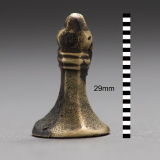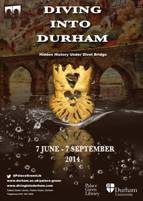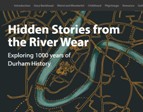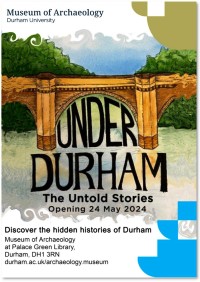about dive into durham
A research project of the Department of Archaeology, Durham University.
 Underwater explorations in the River Wear in Durham City, between April 2007 and September 2023, have revealed an important multi-period
underwater archaeological site yielding a significant collection of everyday material culture totalling over 14,500 objects. They have been
recovered from the submerged riverbed by underwater archaeologist Gary Bankhead through a systematic, self-funded, sub-aqua diving programme
focussed in an area of the river close to the 12th century Elvet Bridge. This remarkable collection of typically small metal finds, known
as the Durham River Wear Assemblage (DRWA), is already challenging the way in which we understand Durham's past. As ordinary and extraordinary
objects they vividly illuminate the day-to-day lives of the countless citizens, artisans, merchants and pilgrims that would have crossed
the bridge on a daily basis. This important assemblage, described as ‘A major research facility, probably the largest collection of late-
and post-medieval finds in the North of England: a unique regional/national resource', has the potential to stimulate
future interpretive research. It also provides valuable comparable material and an important reference resource for anyone studying similar
material culture in published archaeological assemblages from other smaller towns and cities in Britain.
Underwater explorations in the River Wear in Durham City, between April 2007 and September 2023, have revealed an important multi-period
underwater archaeological site yielding a significant collection of everyday material culture totalling over 14,500 objects. They have been
recovered from the submerged riverbed by underwater archaeologist Gary Bankhead through a systematic, self-funded, sub-aqua diving programme
focussed in an area of the river close to the 12th century Elvet Bridge. This remarkable collection of typically small metal finds, known
as the Durham River Wear Assemblage (DRWA), is already challenging the way in which we understand Durham's past. As ordinary and extraordinary
objects they vividly illuminate the day-to-day lives of the countless citizens, artisans, merchants and pilgrims that would have crossed
the bridge on a daily basis. This important assemblage, described as ‘A major research facility, probably the largest collection of late-
and post-medieval finds in the North of England: a unique regional/national resource', has the potential to stimulate
future interpretive research. It also provides valuable comparable material and an important reference resource for anyone studying similar
material culture in published archaeological assemblages from other smaller towns and cities in Britain.
Although an initial chronological study of the objects suggests that their main period of use effectively mirrors Durham’s late- and post-medieval past – from the 13th through to the early-19th century – there appears a peak, in terms of object typologies and totals, to a period of use between the Tudor and Stuart dynasties. However, many objects can be ascribed to an earlier time, a time that coincided with the original period of urban expansion which occurred outside of the peninsula's fortified walls during the 12th–15th centuries following the construction of the masonry arched Elvet Bridge. This ‘Elvet’ archaeological site, together with its important assemblage of finds, actively contributes to the rich archaeological record of the Durham World Heritage Site (Petts 2015). The archive has been deposited with the Museum of Archaeology, Durham University and allocated the Museum prefix DURMA.2024.1. (search online via: Search Our Collections - Durham University).
One of the key aims of our work is to record and research the objects using archaeology students along with specialists with more traditional archaeological skills from finds drawing to comparative analysis and developing typologies. It is envisaged that this material will be published in volumes of a popular archaeology monograph series, plus papers in academic journals. Once complete, permanent public and academic access to the identified objects of assemblage and their associated research will be achieved through placing object details on the Durham University Museum catalogue. Public attention will be focussed on the assemblage though local lectures, exhibiting in a number of local museum venues and through its connection to the present people of Durham by publishing a popular booklet in partnership with the Durham City Freemen.
The DRWA positively contributes to the North-East England Research Group's aim to explore the archaeology and historic environment of North-East England. One of the unique aspects of this group is that their research is underpinned by work carried out by academics, the commercial sector and in co-operation with community groups.





Exhibitions
Hundreds of the artefacts have already appeared on display in exhibitions, including: 'Diving into Durham' (Palace Green Library - June-Sept 2014), 'Plots & Spangles: The Embroidered Vestments of Helena Wintour' (Auckland Castle, Bishop Auckland - Oct-April 2016), the 'Living on the Hills, 10,000 Years of Durham exhibition at Palace Green Library (2016-2020), and in the Department of Archaeology, Durham University (2015-2020).
In June 2021, MA Museum and Artefact students from Durham University, working closely with Gary Bankhead, curated an exciting the online exhibition: 'Hidden Stories from the River Wear - Exploring 1000 years of Durham History'. The exhibition explores hundreds of objects revealing their hidden stories to dive deeper into Durham’s past.
In February 2023, Gary Bankhead co-curated the 'Stories from the River: Exploring the history of Durham, the finds of underwater archaeologist Gary Bankhead' exhibition explored the stories connected through objects discovered in the River Wear, evoking the social history of Durham’s past 800 years. The exhibition featured around 200 of the 14,500 artefacts that have been found in the River Wear in a friendly-family display.
In June 2023, the evoking 'Throwing it Out There - The Archaeology of Ritual, Rivers and Rubbish' exhibition, curated by 'MA Museum and Artefact Studies' students at Durham University, explores the possible ritual meanings behind objects found in rivers in County Durham. The exhibition also includes non-ritual items which may be considered rubbish by some, but are important to archaeologists as they can provide vital information about the past. The exhibition allows visitors to uncover a story of thousands of years from the River Wear and the River Tees. These rivers hold everything from Roman ritual and medieval pilgrimage, to tales from daily life in the past of love, loss and the occasional dropped children’s toy. Comprising objects found by Bob Middlemass & Rolfe Mitchinson, Gary Bankhead, and David & Kevin Hopper, the exhibition covers ritual deposition in watery places from the Bronze Age (2400 BC - 800 BC), through the Roman period (43 AD - 410 AD), and up to the late 1900s.
In May 2024, 'MA Museum and Artefact Studies' students at Durham University, curated the 'Under Durham: The Untold Stories' exhibition. This exhibition focuses on a few unique stories of individuals, objects for special celebrations, and objects used in everyday life – even some that you might recognise from home. With material from the collections of Gary Bankhead and the Museum of Archaeology, this exhibition displays objects that have never been shown and stories that have never been told.